Importance of Communication in a Professional Context
VerifiedAdded on 2023/06/04
|9
|2396
|207
Report
AI Summary
This report delves into the multifaceted realm of communication within a professional context, dissecting key elements such as effective presentation skills, grammatical precision, and the significance of correct spelling. It examines a World Wildlife Fund (WWF) campaign and its persuasive communication strategies, as well as the pervasive issue of corruption in environmental decision-making, highlighting governmental responses and remedial actions. Furthermore, the report explores the critical role of communication in customer relations, emphasizing active listening, cultural sensitivity, and the avoidance of jargon. The author also discusses the application of intercultural communication and oral presentation skills, emphasizing their importance in adapting to diverse work environments and enhancing global workforce value. The report concludes by underscoring the importance of structured message delivery, presentation aids, and audience engagement in achieving effective communication outcomes.
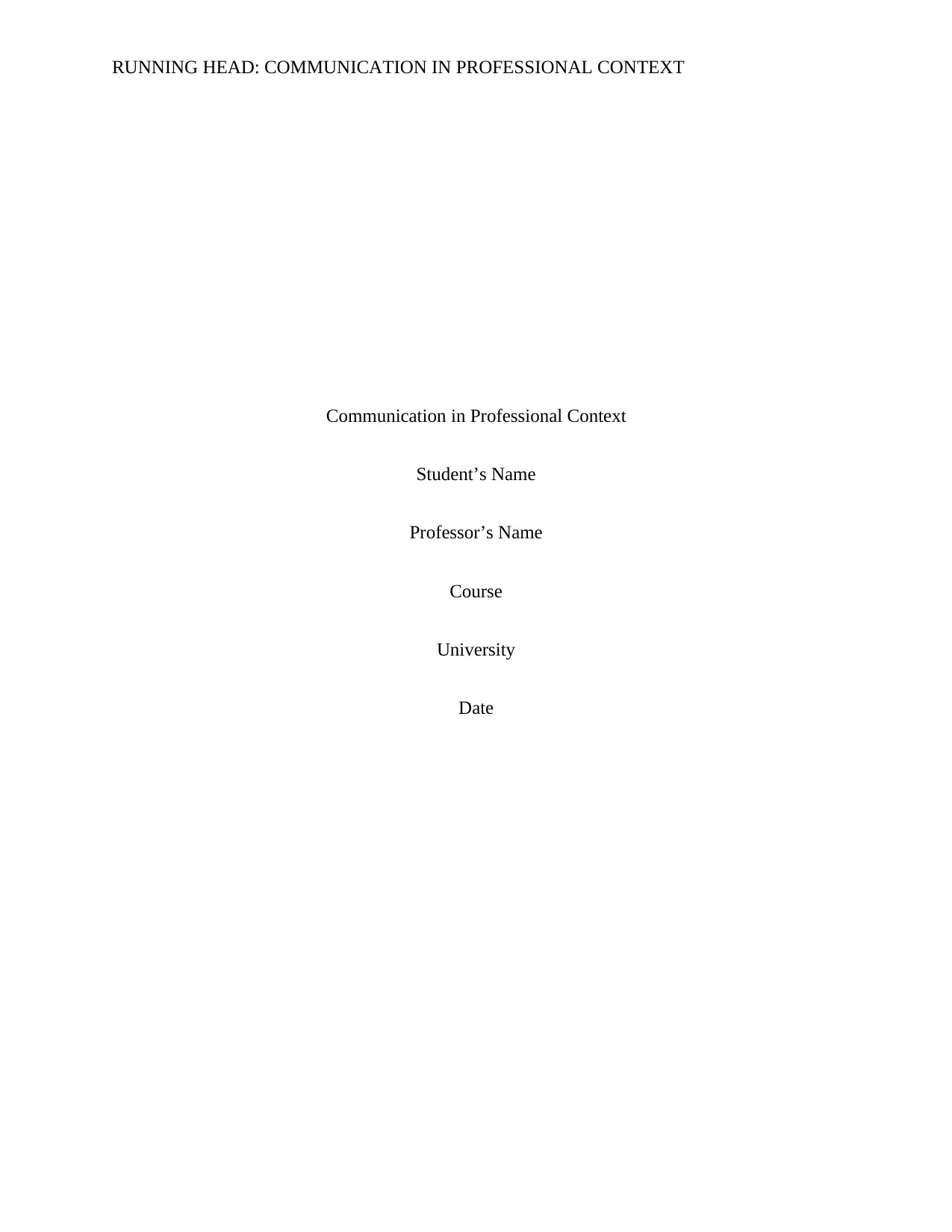
RUNNING HEAD: COMMUNICATION IN PROFESSIONAL CONTEXT
Communication in Professional Context
Student’s Name
Professor’s Name
Course
University
Date
Communication in Professional Context
Student’s Name
Professor’s Name
Course
University
Date
Paraphrase This Document
Need a fresh take? Get an instant paraphrase of this document with our AI Paraphraser
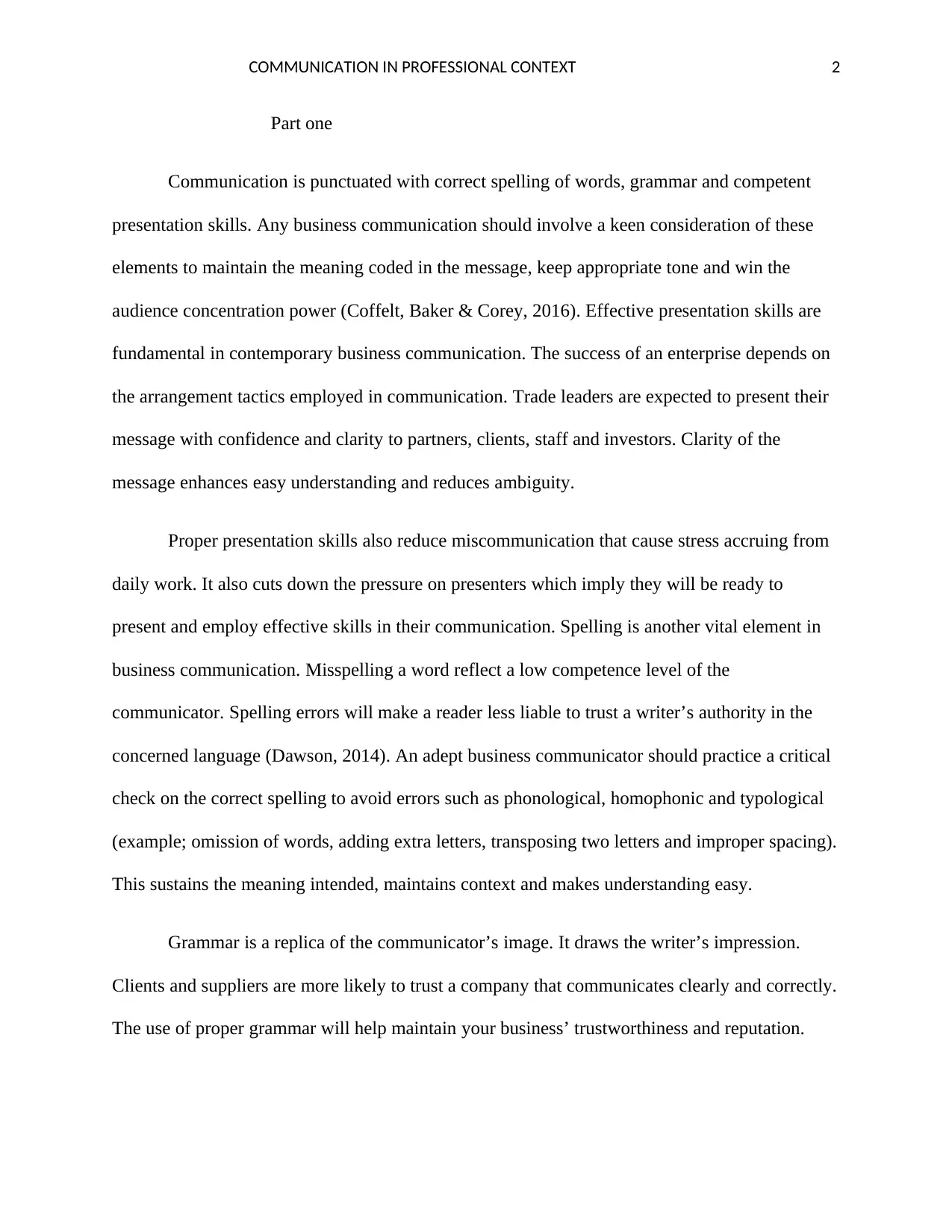
COMMUNICATION IN PROFESSIONAL CONTEXT 2
Part one
Communication is punctuated with correct spelling of words, grammar and competent
presentation skills. Any business communication should involve a keen consideration of these
elements to maintain the meaning coded in the message, keep appropriate tone and win the
audience concentration power (Coffelt, Baker & Corey, 2016). Effective presentation skills are
fundamental in contemporary business communication. The success of an enterprise depends on
the arrangement tactics employed in communication. Trade leaders are expected to present their
message with confidence and clarity to partners, clients, staff and investors. Clarity of the
message enhances easy understanding and reduces ambiguity.
Proper presentation skills also reduce miscommunication that cause stress accruing from
daily work. It also cuts down the pressure on presenters which imply they will be ready to
present and employ effective skills in their communication. Spelling is another vital element in
business communication. Misspelling a word reflect a low competence level of the
communicator. Spelling errors will make a reader less liable to trust a writer’s authority in the
concerned language (Dawson, 2014). An adept business communicator should practice a critical
check on the correct spelling to avoid errors such as phonological, homophonic and typological
(example; omission of words, adding extra letters, transposing two letters and improper spacing).
This sustains the meaning intended, maintains context and makes understanding easy.
Grammar is a replica of the communicator’s image. It draws the writer’s impression.
Clients and suppliers are more likely to trust a company that communicates clearly and correctly.
The use of proper grammar will help maintain your business’ trustworthiness and reputation.
Part one
Communication is punctuated with correct spelling of words, grammar and competent
presentation skills. Any business communication should involve a keen consideration of these
elements to maintain the meaning coded in the message, keep appropriate tone and win the
audience concentration power (Coffelt, Baker & Corey, 2016). Effective presentation skills are
fundamental in contemporary business communication. The success of an enterprise depends on
the arrangement tactics employed in communication. Trade leaders are expected to present their
message with confidence and clarity to partners, clients, staff and investors. Clarity of the
message enhances easy understanding and reduces ambiguity.
Proper presentation skills also reduce miscommunication that cause stress accruing from
daily work. It also cuts down the pressure on presenters which imply they will be ready to
present and employ effective skills in their communication. Spelling is another vital element in
business communication. Misspelling a word reflect a low competence level of the
communicator. Spelling errors will make a reader less liable to trust a writer’s authority in the
concerned language (Dawson, 2014). An adept business communicator should practice a critical
check on the correct spelling to avoid errors such as phonological, homophonic and typological
(example; omission of words, adding extra letters, transposing two letters and improper spacing).
This sustains the meaning intended, maintains context and makes understanding easy.
Grammar is a replica of the communicator’s image. It draws the writer’s impression.
Clients and suppliers are more likely to trust a company that communicates clearly and correctly.
The use of proper grammar will help maintain your business’ trustworthiness and reputation.

COMMUNICATION IN PROFESSIONAL CONTEXT 3
Part two
The Save paper, save the planet campaign is World Wildlife Fund (WWF) initiative
educate people on the extreme use of waste papers. The organization communicates to
individuals by use of images. The photo used in the advert includes the bathroom dispenser that
is worn out by a hand of human. The colors used are green and black. At the there is a man’s and
pulling a green piece of paper gradually. The dispenser takes the wider part of the border. From
the designing the image, the death of the continent is symbolized by the fishing out of each paper
(Coffelt et al., 2016). The dispenser getting empty signifies that the papers get finished. The
silhouette of the continent connotes the cause, effects and consequences of paper usage. The use
of persuasion make the message convincing and credible.
The messaged being passed is targeting people of all times. It is evident in the image that
saving the planet start primarily with proper using or saving of the paper. This is because the
existence of forest is link to what we use. The setting in which the advert is presented can be a
hindrance to how the message can be received. Being a web advert, it may become uneasy for
common people to may not take pride in environmental concerns, (Lear, Hodge & Schulz,
2015) . The caption is precise and do not give direct explanation of what should be done to save
paper and the planet respectively.
Part three
Corruption, from the report on; “Corruption in environmental decision-making is
widespread in ecological planning and resource management. The report states that one-third of
complaints presented to Independent Commission Against Corruption (ICAC) were issues
Part two
The Save paper, save the planet campaign is World Wildlife Fund (WWF) initiative
educate people on the extreme use of waste papers. The organization communicates to
individuals by use of images. The photo used in the advert includes the bathroom dispenser that
is worn out by a hand of human. The colors used are green and black. At the there is a man’s and
pulling a green piece of paper gradually. The dispenser takes the wider part of the border. From
the designing the image, the death of the continent is symbolized by the fishing out of each paper
(Coffelt et al., 2016). The dispenser getting empty signifies that the papers get finished. The
silhouette of the continent connotes the cause, effects and consequences of paper usage. The use
of persuasion make the message convincing and credible.
The messaged being passed is targeting people of all times. It is evident in the image that
saving the planet start primarily with proper using or saving of the paper. This is because the
existence of forest is link to what we use. The setting in which the advert is presented can be a
hindrance to how the message can be received. Being a web advert, it may become uneasy for
common people to may not take pride in environmental concerns, (Lear, Hodge & Schulz,
2015) . The caption is precise and do not give direct explanation of what should be done to save
paper and the planet respectively.
Part three
Corruption, from the report on; “Corruption in environmental decision-making is
widespread in ecological planning and resource management. The report states that one-third of
complaints presented to Independent Commission Against Corruption (ICAC) were issues
⊘ This is a preview!⊘
Do you want full access?
Subscribe today to unlock all pages.

Trusted by 1+ million students worldwide
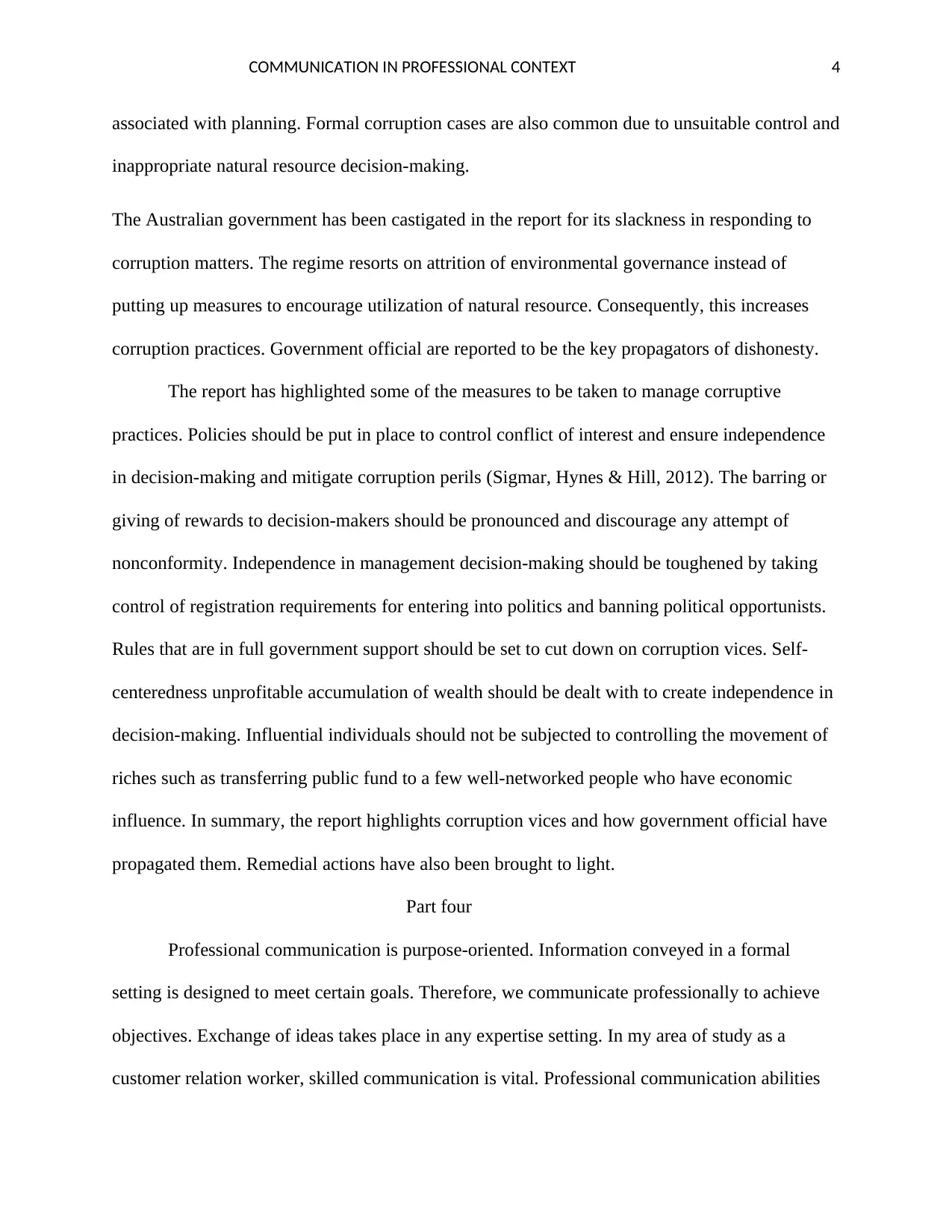
COMMUNICATION IN PROFESSIONAL CONTEXT 4
associated with planning. Formal corruption cases are also common due to unsuitable control and
inappropriate natural resource decision-making.
The Australian government has been castigated in the report for its slackness in responding to
corruption matters. The regime resorts on attrition of environmental governance instead of
putting up measures to encourage utilization of natural resource. Consequently, this increases
corruption practices. Government official are reported to be the key propagators of dishonesty.
The report has highlighted some of the measures to be taken to manage corruptive
practices. Policies should be put in place to control conflict of interest and ensure independence
in decision-making and mitigate corruption perils (Sigmar, Hynes & Hill, 2012). The barring or
giving of rewards to decision-makers should be pronounced and discourage any attempt of
nonconformity. Independence in management decision-making should be toughened by taking
control of registration requirements for entering into politics and banning political opportunists.
Rules that are in full government support should be set to cut down on corruption vices. Self-
centeredness unprofitable accumulation of wealth should be dealt with to create independence in
decision-making. Influential individuals should not be subjected to controlling the movement of
riches such as transferring public fund to a few well-networked people who have economic
influence. In summary, the report highlights corruption vices and how government official have
propagated them. Remedial actions have also been brought to light.
Part four
Professional communication is purpose-oriented. Information conveyed in a formal
setting is designed to meet certain goals. Therefore, we communicate professionally to achieve
objectives. Exchange of ideas takes place in any expertise setting. In my area of study as a
customer relation worker, skilled communication is vital. Professional communication abilities
associated with planning. Formal corruption cases are also common due to unsuitable control and
inappropriate natural resource decision-making.
The Australian government has been castigated in the report for its slackness in responding to
corruption matters. The regime resorts on attrition of environmental governance instead of
putting up measures to encourage utilization of natural resource. Consequently, this increases
corruption practices. Government official are reported to be the key propagators of dishonesty.
The report has highlighted some of the measures to be taken to manage corruptive
practices. Policies should be put in place to control conflict of interest and ensure independence
in decision-making and mitigate corruption perils (Sigmar, Hynes & Hill, 2012). The barring or
giving of rewards to decision-makers should be pronounced and discourage any attempt of
nonconformity. Independence in management decision-making should be toughened by taking
control of registration requirements for entering into politics and banning political opportunists.
Rules that are in full government support should be set to cut down on corruption vices. Self-
centeredness unprofitable accumulation of wealth should be dealt with to create independence in
decision-making. Influential individuals should not be subjected to controlling the movement of
riches such as transferring public fund to a few well-networked people who have economic
influence. In summary, the report highlights corruption vices and how government official have
propagated them. Remedial actions have also been brought to light.
Part four
Professional communication is purpose-oriented. Information conveyed in a formal
setting is designed to meet certain goals. Therefore, we communicate professionally to achieve
objectives. Exchange of ideas takes place in any expertise setting. In my area of study as a
customer relation worker, skilled communication is vital. Professional communication abilities
Paraphrase This Document
Need a fresh take? Get an instant paraphrase of this document with our AI Paraphraser

COMMUNICATION IN PROFESSIONAL CONTEXT 5
are, therefore, highlighted as the most significant elements that determine values of people in
places of work. This is because when professional communication skills are not put into use, it
may become quite difficult to create understanding with my clients in the field. Adept
communication is the central harmonizing to facilitate winning and maintaining customers.
Customer relation is a communication driven department that requires professional
handling of customers. It requires the ability to pay attention ( Bondi, & Yu 2018). Clients need
to perceive the business’ operation and how their specification of their needs can be addressed.
Listening to customers’ opinions calls for an art of professionalism in communication. The
success of a business involves focusing on consumers feedback on service provision and goods
offered because they have a substantial finance contribution in the corporation. Customer
reactions enable the department to identify under servicing areas and take an appropriate course
of action for improvement (Al Obaidani, 2018). As a skilled communicator, I should listen to the
clients with a view to learning and taking remedial step but not to criticize.
Customer relation is a profession that entails assorted range of clients. As a consumer
relation professional, cultural barriers can have an elevated impending hindrance to any message
delivery. The skills required for competent communication, therefore, involve shunning the use
of technical because the career brings on board clients from all levels of life. Explaining ideas to
the customers requires professionalism in communication (Mitchell, Skinner & White, 2010).
This may include responding to their reactions and enlightening them on the changes made in
terms of goods offered and service provision. Avoiding the use of jargons will create room for
understanding and ensure harmonized communication and contribution towards achieving the
organizational strategic objectives. This can be realized through informing clients of the relevant
are, therefore, highlighted as the most significant elements that determine values of people in
places of work. This is because when professional communication skills are not put into use, it
may become quite difficult to create understanding with my clients in the field. Adept
communication is the central harmonizing to facilitate winning and maintaining customers.
Customer relation is a communication driven department that requires professional
handling of customers. It requires the ability to pay attention ( Bondi, & Yu 2018). Clients need
to perceive the business’ operation and how their specification of their needs can be addressed.
Listening to customers’ opinions calls for an art of professionalism in communication. The
success of a business involves focusing on consumers feedback on service provision and goods
offered because they have a substantial finance contribution in the corporation. Customer
reactions enable the department to identify under servicing areas and take an appropriate course
of action for improvement (Al Obaidani, 2018). As a skilled communicator, I should listen to the
clients with a view to learning and taking remedial step but not to criticize.
Customer relation is a profession that entails assorted range of clients. As a consumer
relation professional, cultural barriers can have an elevated impending hindrance to any message
delivery. The skills required for competent communication, therefore, involve shunning the use
of technical because the career brings on board clients from all levels of life. Explaining ideas to
the customers requires professionalism in communication (Mitchell, Skinner & White, 2010).
This may include responding to their reactions and enlightening them on the changes made in
terms of goods offered and service provision. Avoiding the use of jargons will create room for
understanding and ensure harmonized communication and contribution towards achieving the
organizational strategic objectives. This can be realized through informing clients of the relevant
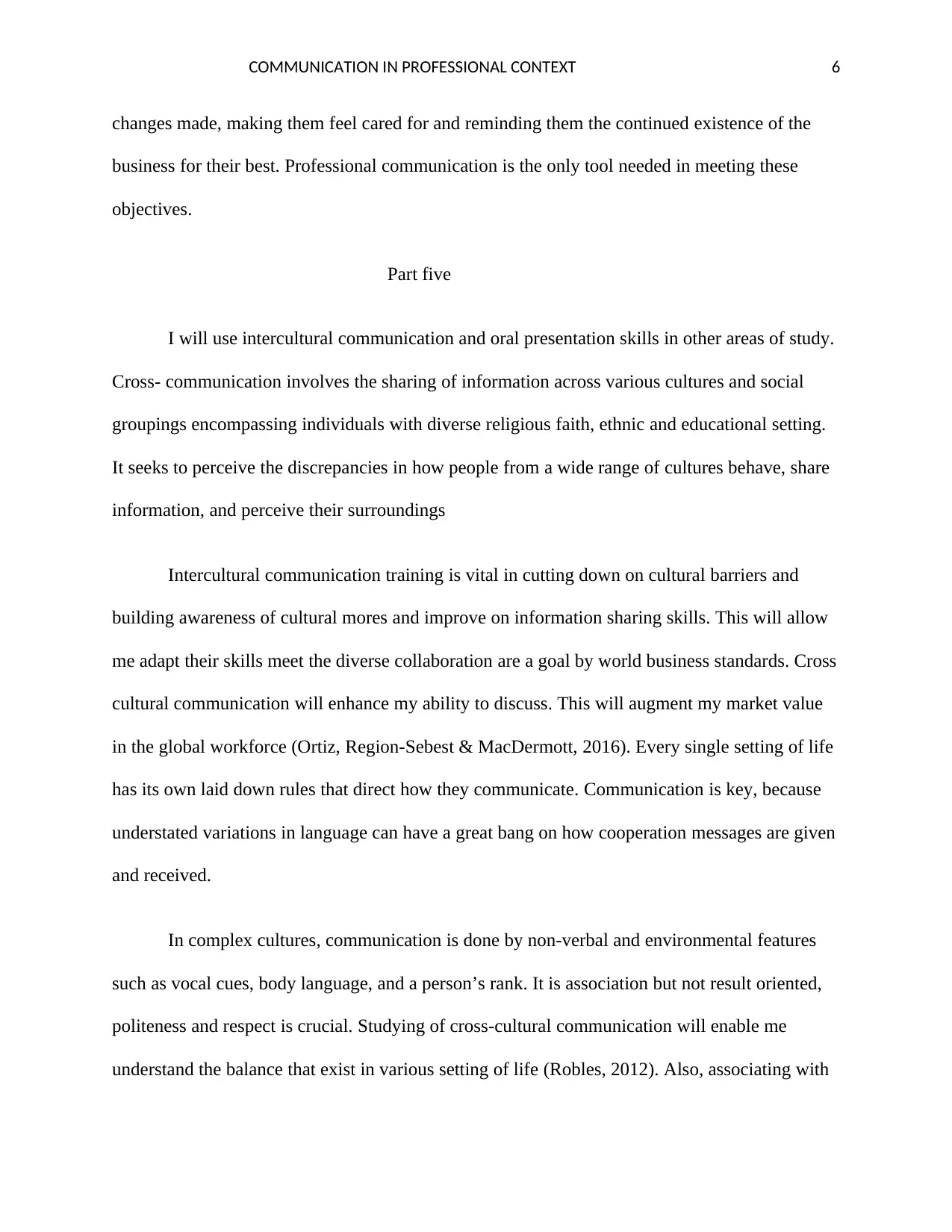
COMMUNICATION IN PROFESSIONAL CONTEXT 6
changes made, making them feel cared for and reminding them the continued existence of the
business for their best. Professional communication is the only tool needed in meeting these
objectives.
Part five
I will use intercultural communication and oral presentation skills in other areas of study.
Cross- communication involves the sharing of information across various cultures and social
groupings encompassing individuals with diverse religious faith, ethnic and educational setting.
It seeks to perceive the discrepancies in how people from a wide range of cultures behave, share
information, and perceive their surroundings
Intercultural communication training is vital in cutting down on cultural barriers and
building awareness of cultural mores and improve on information sharing skills. This will allow
me adapt their skills meet the diverse collaboration are a goal by world business standards. Cross
cultural communication will enhance my ability to discuss. This will augment my market value
in the global workforce (Ortiz, Region-Sebest & MacDermott, 2016). Every single setting of life
has its own laid down rules that direct how they communicate. Communication is key, because
understated variations in language can have a great bang on how cooperation messages are given
and received.
In complex cultures, communication is done by non-verbal and environmental features
such as vocal cues, body language, and a person’s rank. It is association but not result oriented,
politeness and respect is crucial. Studying of cross-cultural communication will enable me
understand the balance that exist in various setting of life (Robles, 2012). Also, associating with
changes made, making them feel cared for and reminding them the continued existence of the
business for their best. Professional communication is the only tool needed in meeting these
objectives.
Part five
I will use intercultural communication and oral presentation skills in other areas of study.
Cross- communication involves the sharing of information across various cultures and social
groupings encompassing individuals with diverse religious faith, ethnic and educational setting.
It seeks to perceive the discrepancies in how people from a wide range of cultures behave, share
information, and perceive their surroundings
Intercultural communication training is vital in cutting down on cultural barriers and
building awareness of cultural mores and improve on information sharing skills. This will allow
me adapt their skills meet the diverse collaboration are a goal by world business standards. Cross
cultural communication will enhance my ability to discuss. This will augment my market value
in the global workforce (Ortiz, Region-Sebest & MacDermott, 2016). Every single setting of life
has its own laid down rules that direct how they communicate. Communication is key, because
understated variations in language can have a great bang on how cooperation messages are given
and received.
In complex cultures, communication is done by non-verbal and environmental features
such as vocal cues, body language, and a person’s rank. It is association but not result oriented,
politeness and respect is crucial. Studying of cross-cultural communication will enable me
understand the balance that exist in various setting of life (Robles, 2012). Also, associating with
⊘ This is a preview!⊘
Do you want full access?
Subscribe today to unlock all pages.

Trusted by 1+ million students worldwide
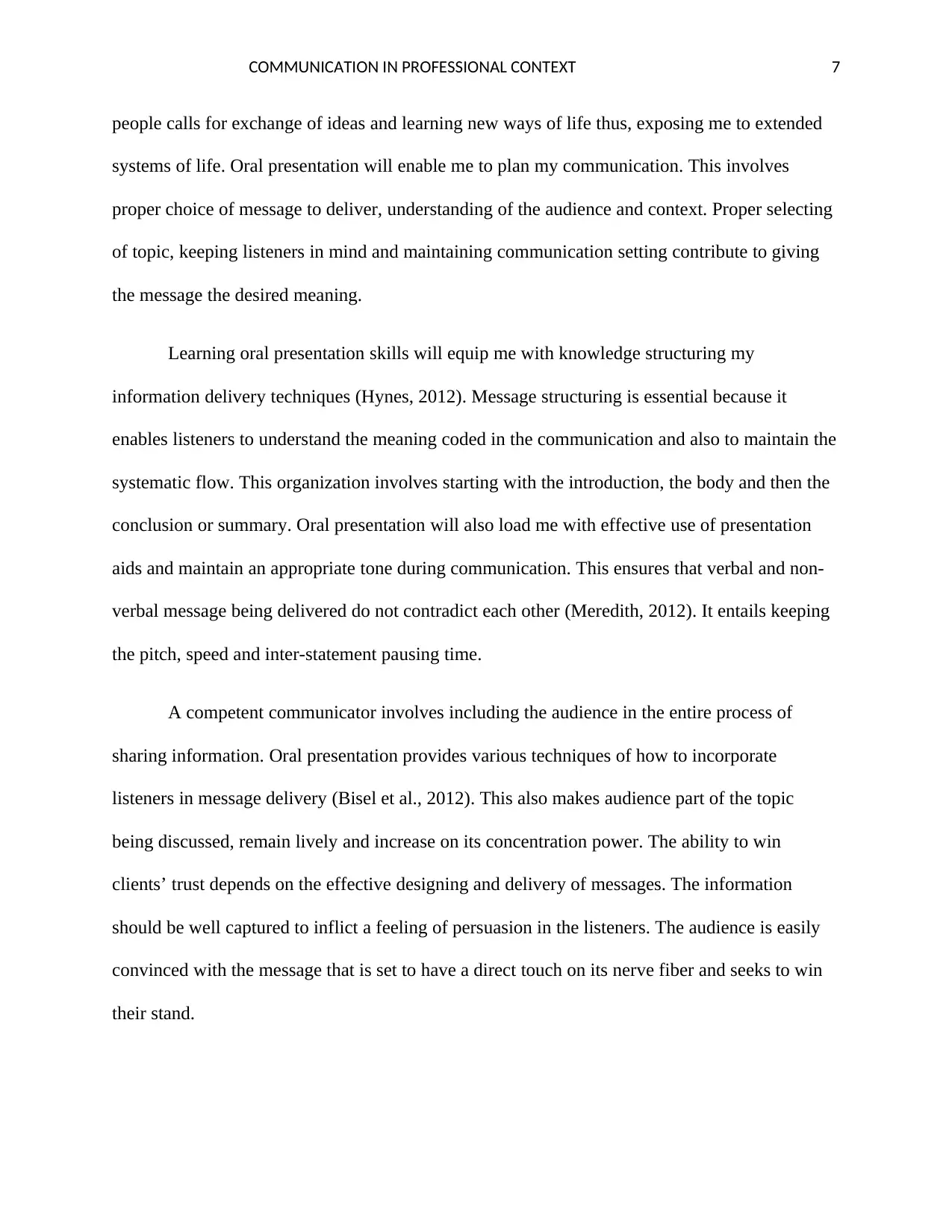
COMMUNICATION IN PROFESSIONAL CONTEXT 7
people calls for exchange of ideas and learning new ways of life thus, exposing me to extended
systems of life. Oral presentation will enable me to plan my communication. This involves
proper choice of message to deliver, understanding of the audience and context. Proper selecting
of topic, keeping listeners in mind and maintaining communication setting contribute to giving
the message the desired meaning.
Learning oral presentation skills will equip me with knowledge structuring my
information delivery techniques (Hynes, 2012). Message structuring is essential because it
enables listeners to understand the meaning coded in the communication and also to maintain the
systematic flow. This organization involves starting with the introduction, the body and then the
conclusion or summary. Oral presentation will also load me with effective use of presentation
aids and maintain an appropriate tone during communication. This ensures that verbal and non-
verbal message being delivered do not contradict each other (Meredith, 2012). It entails keeping
the pitch, speed and inter-statement pausing time.
A competent communicator involves including the audience in the entire process of
sharing information. Oral presentation provides various techniques of how to incorporate
listeners in message delivery (Bisel et al., 2012). This also makes audience part of the topic
being discussed, remain lively and increase on its concentration power. The ability to win
clients’ trust depends on the effective designing and delivery of messages. The information
should be well captured to inflict a feeling of persuasion in the listeners. The audience is easily
convinced with the message that is set to have a direct touch on its nerve fiber and seeks to win
their stand.
people calls for exchange of ideas and learning new ways of life thus, exposing me to extended
systems of life. Oral presentation will enable me to plan my communication. This involves
proper choice of message to deliver, understanding of the audience and context. Proper selecting
of topic, keeping listeners in mind and maintaining communication setting contribute to giving
the message the desired meaning.
Learning oral presentation skills will equip me with knowledge structuring my
information delivery techniques (Hynes, 2012). Message structuring is essential because it
enables listeners to understand the meaning coded in the communication and also to maintain the
systematic flow. This organization involves starting with the introduction, the body and then the
conclusion or summary. Oral presentation will also load me with effective use of presentation
aids and maintain an appropriate tone during communication. This ensures that verbal and non-
verbal message being delivered do not contradict each other (Meredith, 2012). It entails keeping
the pitch, speed and inter-statement pausing time.
A competent communicator involves including the audience in the entire process of
sharing information. Oral presentation provides various techniques of how to incorporate
listeners in message delivery (Bisel et al., 2012). This also makes audience part of the topic
being discussed, remain lively and increase on its concentration power. The ability to win
clients’ trust depends on the effective designing and delivery of messages. The information
should be well captured to inflict a feeling of persuasion in the listeners. The audience is easily
convinced with the message that is set to have a direct touch on its nerve fiber and seeks to win
their stand.
Paraphrase This Document
Need a fresh take? Get an instant paraphrase of this document with our AI Paraphraser
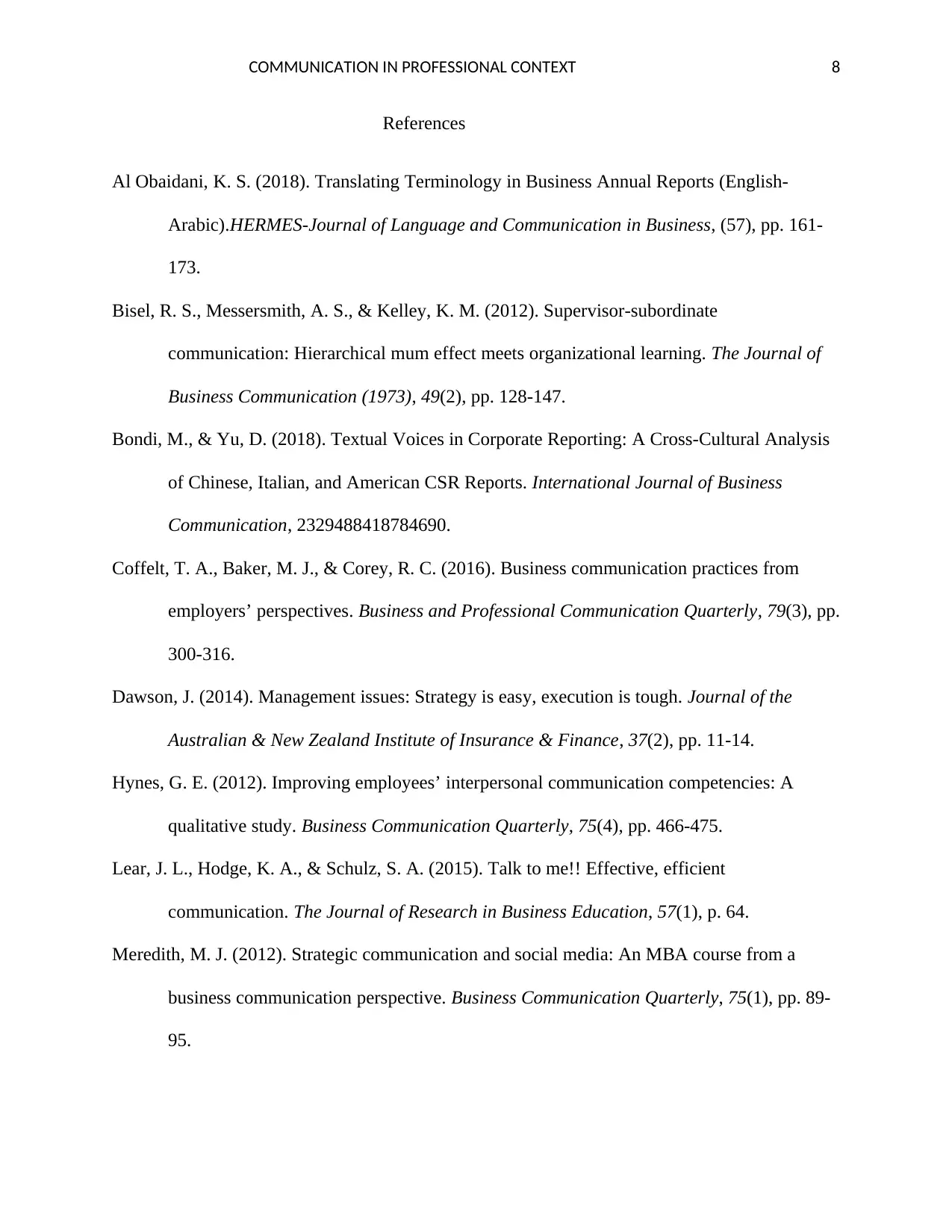
COMMUNICATION IN PROFESSIONAL CONTEXT 8
References
Al Obaidani, K. S. (2018). Translating Terminology in Business Annual Reports (English-
Arabic).HERMES-Journal of Language and Communication in Business, (57), pp. 161-
173.
Bisel, R. S., Messersmith, A. S., & Kelley, K. M. (2012). Supervisor-subordinate
communication: Hierarchical mum effect meets organizational learning. The Journal of
Business Communication (1973), 49(2), pp. 128-147.
Bondi, M., & Yu, D. (2018). Textual Voices in Corporate Reporting: A Cross-Cultural Analysis
of Chinese, Italian, and American CSR Reports. International Journal of Business
Communication, 2329488418784690.
Coffelt, T. A., Baker, M. J., & Corey, R. C. (2016). Business communication practices from
employers’ perspectives. Business and Professional Communication Quarterly, 79(3), pp.
300-316.
Dawson, J. (2014). Management issues: Strategy is easy, execution is tough. Journal of the
Australian & New Zealand Institute of Insurance & Finance, 37(2), pp. 11-14.
Hynes, G. E. (2012). Improving employees’ interpersonal communication competencies: A
qualitative study. Business Communication Quarterly, 75(4), pp. 466-475.
Lear, J. L., Hodge, K. A., & Schulz, S. A. (2015). Talk to me!! Effective, efficient
communication. The Journal of Research in Business Education, 57(1), p. 64.
Meredith, M. J. (2012). Strategic communication and social media: An MBA course from a
business communication perspective. Business Communication Quarterly, 75(1), pp. 89-
95.
References
Al Obaidani, K. S. (2018). Translating Terminology in Business Annual Reports (English-
Arabic).HERMES-Journal of Language and Communication in Business, (57), pp. 161-
173.
Bisel, R. S., Messersmith, A. S., & Kelley, K. M. (2012). Supervisor-subordinate
communication: Hierarchical mum effect meets organizational learning. The Journal of
Business Communication (1973), 49(2), pp. 128-147.
Bondi, M., & Yu, D. (2018). Textual Voices in Corporate Reporting: A Cross-Cultural Analysis
of Chinese, Italian, and American CSR Reports. International Journal of Business
Communication, 2329488418784690.
Coffelt, T. A., Baker, M. J., & Corey, R. C. (2016). Business communication practices from
employers’ perspectives. Business and Professional Communication Quarterly, 79(3), pp.
300-316.
Dawson, J. (2014). Management issues: Strategy is easy, execution is tough. Journal of the
Australian & New Zealand Institute of Insurance & Finance, 37(2), pp. 11-14.
Hynes, G. E. (2012). Improving employees’ interpersonal communication competencies: A
qualitative study. Business Communication Quarterly, 75(4), pp. 466-475.
Lear, J. L., Hodge, K. A., & Schulz, S. A. (2015). Talk to me!! Effective, efficient
communication. The Journal of Research in Business Education, 57(1), p. 64.
Meredith, M. J. (2012). Strategic communication and social media: An MBA course from a
business communication perspective. Business Communication Quarterly, 75(1), pp. 89-
95.
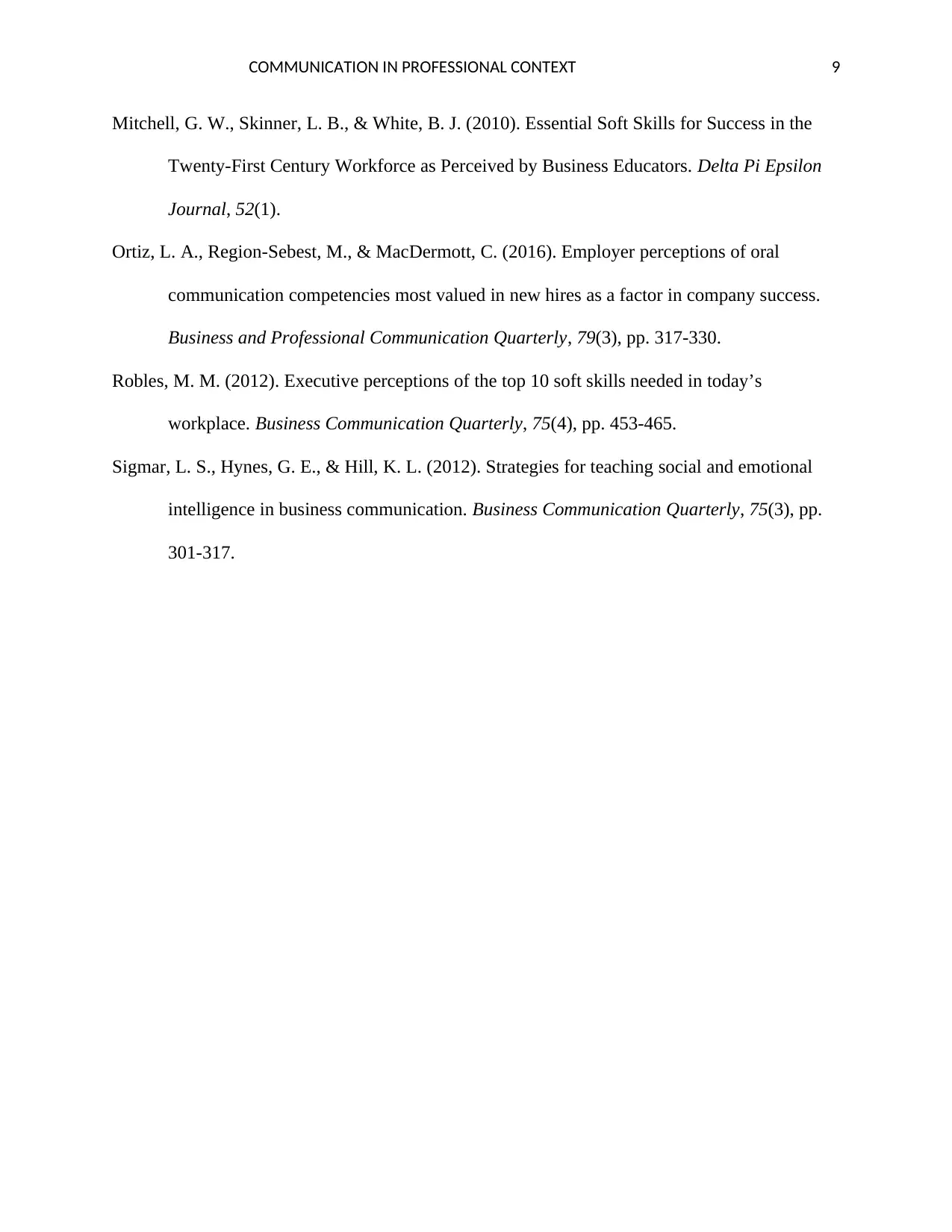
COMMUNICATION IN PROFESSIONAL CONTEXT 9
Mitchell, G. W., Skinner, L. B., & White, B. J. (2010). Essential Soft Skills for Success in the
Twenty-First Century Workforce as Perceived by Business Educators. Delta Pi Epsilon
Journal, 52(1).
Ortiz, L. A., Region-Sebest, M., & MacDermott, C. (2016). Employer perceptions of oral
communication competencies most valued in new hires as a factor in company success.
Business and Professional Communication Quarterly, 79(3), pp. 317-330.
Robles, M. M. (2012). Executive perceptions of the top 10 soft skills needed in today’s
workplace. Business Communication Quarterly, 75(4), pp. 453-465.
Sigmar, L. S., Hynes, G. E., & Hill, K. L. (2012). Strategies for teaching social and emotional
intelligence in business communication. Business Communication Quarterly, 75(3), pp.
301-317.
Mitchell, G. W., Skinner, L. B., & White, B. J. (2010). Essential Soft Skills for Success in the
Twenty-First Century Workforce as Perceived by Business Educators. Delta Pi Epsilon
Journal, 52(1).
Ortiz, L. A., Region-Sebest, M., & MacDermott, C. (2016). Employer perceptions of oral
communication competencies most valued in new hires as a factor in company success.
Business and Professional Communication Quarterly, 79(3), pp. 317-330.
Robles, M. M. (2012). Executive perceptions of the top 10 soft skills needed in today’s
workplace. Business Communication Quarterly, 75(4), pp. 453-465.
Sigmar, L. S., Hynes, G. E., & Hill, K. L. (2012). Strategies for teaching social and emotional
intelligence in business communication. Business Communication Quarterly, 75(3), pp.
301-317.
⊘ This is a preview!⊘
Do you want full access?
Subscribe today to unlock all pages.

Trusted by 1+ million students worldwide
1 out of 9
Your All-in-One AI-Powered Toolkit for Academic Success.
+13062052269
info@desklib.com
Available 24*7 on WhatsApp / Email
![[object Object]](/_next/static/media/star-bottom.7253800d.svg)
Unlock your academic potential
Copyright © 2020–2025 A2Z Services. All Rights Reserved. Developed and managed by ZUCOL.


